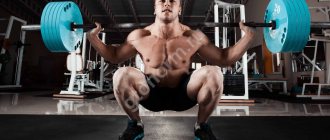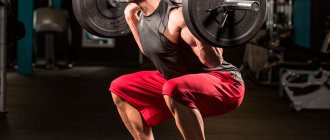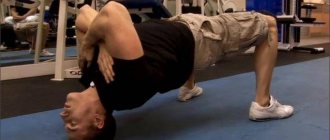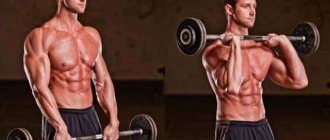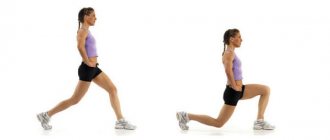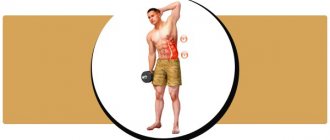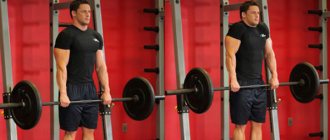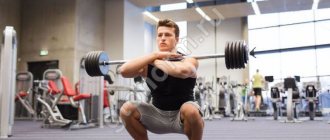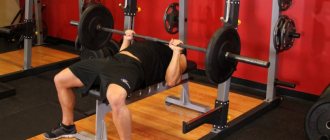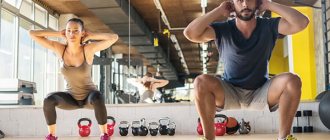December 30, 2020 Admin Home page » Back extensors
The correct technique for performing deadlifts on straight legs is described, the muscles being trained are described, important tips for better results + a video for a clear example of execution.
The benefits and harms of good morning exercises
The undeniable benefits for a healthy person are as follows:
- The exercise creates toned and voluminous gluteal muscles by stretching them and engaging them in work without a large number of synergistic muscles.
- Bending eliminates the work of the quadriceps completely and involves the hamstrings to a lesser extent.
- Good morning strengthens the muscles of the lumbar spine, which are responsible for stabilizing the back and beautiful posture.
- There is a seated version of the exercise that completely eliminates the work of the hips.
- Good morning exercises generally strengthen the muscles in the back of your body and make them more flexible.
The exercise can cause harm if: Improper technique is performed, in which the muscles do not fix the spine and rounding of the lumbar and thoracic region is formed, which injures the spine and leads to back pain.
Execution technique
Before including straight-legged deadlifts in the training process, a number of conditions must be met. The deadlift is a very difficult exercise; you can start it only after sufficiently mastering the classic deadlift technique and achieving at least some results in it.
All types of deadlifts have high requirements for the skill of fixing a straight position of the back, but for the exercise in question this requirement must be doubled. This is due to the fact that the torso and legs here are at a large angle relative to each other.
If you have ever had back problems (even minor ones), you should consult a doctor for advice before doing any back exercises.
It is better not to attempt deadlifts without a good stretch. At a minimum, the athlete should be able to reach his palms to the floor with his legs straight. It is important to have stretched Achilles tendons.
If you are not up to par in this regard, take a few weeks to do consistent stretching. During this time, it is better either not to practice deadlifts at all, or to do them with a very light weight, and the barbell should be placed on a hill (plates or plinths).
Some people's anatomical abilities may mean that even with an ideal stretch, it will be impossible to perform a deadlift at a certain amplitude without arching the back. In this case, you need to adjust it to suit yourself using large pancakes and other means of increasing the initial height of the projectile.
It is necessary to achieve such an amplitude at which the back remains straight throughout the entire movement.
Starting position: legs are at a short distance from each other, feet are parallel. The grip width is at the level of the pelvis or slightly more. The feet should be under the bar at such a distance that the shins touch it.
The legs must be level, otherwise a torque will arise during the movement. The buttocks should be pulled back as far as possible. The back is straight, the shoulder blades are brought together. The knees should be slightly bent; you should absolutely not bend them inward.
Smoothly lift the barbell. The head should look forward and not droop. The projectile goes close to the shins, without moving away from it. Upon reaching the top point, you need to secure your body in a straight position and straighten your knees. You cannot lean back, this puts unnecessary stress on the lower back.
Lowering the barbell begins by simultaneously bending forward and bending your knees. The trajectory of movement must be identical to that which was when the projectile was lifted. Exhalation is done during the ascent, when moving down the breath is held, inhalation is made at the top point.
Adviсe
- Even though the exercise is called a straight leg row, there should be some bending in the knees. Smaller than in the classic deadlift, but sufficient to keep the lower back straight at the lowest point.
- The weight should be taken significantly less than in the classic deadlift. You should start with a weight of about half your body weight. It should be added in the amount of about 2-4 kg per week.
- The retraction of the shoulder blades is an indicator of the straightness of the back. If they are separated, the exercise is performed incorrectly and the risk of injury increases. If you don’t have enough strength to hold your shoulder blades, you should take less weight and strengthen the muscles responsible for this with shrugs, etc. If the shoulder blades begin to spread apart when lifting the barbell, you should immediately stop performing the exercise by lowering the apparatus to the floor. It is also worth monitoring the correct position of the lumbar region.
- The center of gravity is on the heels.
- Deadlifts, unlike classic ones, are not done for a small number of repetitions. — The optimal number of repetitions per approach is 5-15. However, you should not do this exercise to failure, as this increases the risk of violating the correct technique. It is best to complete the exercise 1-2 repetitions before failure.
- The main lever here is the pelvis; its forward arching gives impetus to the entire movement.
- The use of straps is not recommended. The deadlift does not lift extreme weights, which means that the wrists receive a moderate load, which will benefit them in strengthening them. You should not deprive them of this opportunity.
- It is enough to perform deadlifts once a week.
Basic mistakes
- Back arch in the lower back and thoracic region.
- Concentration of effort in the back (the desire to lift the weight with the back muscles), and not in the legs and pelvis.
- Neglecting stretching.
- Lifting the barbell away from the legs during movement.
- The desire to straighten the knees to the detriment of technique
- Shifting the center of gravity from heels to toes
Technique for performing bends while standing with a barbell on your shoulders
- Place the bar on the top of your trapezius muscle and lift it off the rack using a shoulder-width grip. Take two steps back from the frame. Tuck your shoulder blades toward the center of your back and tighten your abdominal muscles.
- Place your feet hip-width apart, parallel to each other.
- As you inhale, bend your knees and push your pelvis back, placing your body weight on your heels, but do not squat. This increases the stretch of the gluteal muscles and hamstrings. Lower your torso parallel to the floor. Do not round your back when tilted, maintain a natural arch in the lumbar region.
- As you exhale, pushing off with your heels, straighten your torso in a concentrated manner using your gluteal muscles, not your back. Fully straighten your pelvis and knees at the top, curling your tailbone down. Under no circumstances should you leave an excessive arch in your lower back.
Sexy buttocks: how to do deadlifts on straight legs
4 5 1
Spring is ahead, and then summer. This means that it’s time to take care of the beauty of your buttocks. And, if you haven’t made yourself sexy buttocks yet, it’s time to get started. How to properly do bends while standing with a barbell in your hands - read in our material.
The straight-legged deadlift is rightfully considered one of the most effective exercises for working the buttocks (only squats are more effective). The main goal of this exercise is to develop the surface of the back thigh, as well as directly work the buttocks. It can be used in a beginner's program.
It is worth noting that the technique of performing this, at first glance, simple exercise, has a number of features that should not be forgotten. In particular, to begin with, you should start working with light weights, and do not rush to add weight. Remember, excessive stress when performing this exercise risks causing a back injury.
If you are working out at home and don’t have a barbell, use dumbbells to perform the exercise.
HOW TO DO STRAIGHT LEGGED PULL-OUTS CORRECTLY
To perform the exercise, stand straight with your feet next to each other. The back is slightly arched at the lower back. Be sure to ensure that it does not round during the exercise. As you inhale, bend forward with your arms holding a barbell or dumbbells. The slope should be as low as possible.
Read also: What exercises can you do at home to lose weight on your sides?
Ideally, when bending, your legs are perfectly straight, but if you feel discomfort, bend them a little
Please also note that when performing the exercise, your gaze should be directed straight ahead. . During the exercise, be sure to keep a slight arch in your lower back.
It cannot be relaxed, since bending over with a barbell should be carried out exclusively through the work of the buttocks and the back of the thigh. If you relax the lower back, the exercises will be performed precisely at its expense.
During the exercise, be sure to maintain a slight arch in your lower back. It cannot be relaxed, since bending over with a barbell should be carried out exclusively through the work of the buttocks and the back of the thigh. If you relax the lower back, the exercises will be performed precisely at its expense.
The effect of including barbell bending in the training process will be visible after just a few weeks of regular training. In particular, the buttocks will begin to tighten, and the back of the thigh will become more elastic. Moreover, this exercise perfectly removes cellulite deposits in work areas.
Read also: How to pump up sexy abs: home training program
To improve your results in getting rid of cellulite, in parallel with your workouts, do regular Dead Sea mud wraps.
Watch online video Sexy buttocks: how to do straight leg deadlifts correctly
Sexy buttocks are beautiful. How to start the buttocks by doing the upper row correctly - read in our material315615https://www.youtube.com/embed/MPSrzdOq5C02016-02-22T13:02:12+02:00T2h43M0S
Technique for performing bends while sitting with a barbell
This option of bending allows you to minimize the load on the hamstrings, but also requires good mobility of the hip joints. For injuries, pain and inflammation in the hip joints, this option is prohibited.
- Place the bar on the top of the trapeze and hold it tightly in one position without letting it roll down onto your neck.
- Sit on the edge of a bench and place your feet wide apart.
- As you inhale, lower your straight back down as low as possible, as far as the flexibility of your muscles and joints allows. Don't round your back. Feel the stretch in your gluteal muscles.
- As you exhale, straighten your torso using your gluteal muscles and return to the starting position.
Technique for performing the element to create the correct physical activity
To practice the exercise, use an empty bar or minimal weight. The athlete’s first priority is to master the correct movements, and only then is full physical activity on the muscles given.
Place your feet the width of the shoulder girdle, take the barbell, placing it on the trapezius muscles, slightly below the cervical region. The spine is straightened, the muscles are tensed during the entire exercise, especially at its lower point. Straighten your shoulders and slightly bend your lower limbs at the knee joints. Performing the element with straight legs requires a high level of stretching and mobility of the hip joints
This option cannot be performed without preparation. Leaving your back in a straight, tense position, carefully tilt your body forward until it forms a parallel line with the floor surface. The action is carried out through the hip joints, moving the buttocks back. Tightening the muscles of the buttocks and thighs, return to the starting position and repeat the exercise the required number of times.
To perform it safely, you should not immediately do deep bends; you must remember that the range of movements depends on the elasticity of the hamstrings.
An option for performing the element is bending over with a barbell in a sitting position:
- The barbell is placed on the trapezius muscles and sat on the edge of the bench. Straighten the thoracic and shoulder regions, straighten the spine, and maintain a physiological deflection in the lower back. Feet rest on the floor, toes point to the sides.
- They lower themselves down until it is possible to maintain a straight back. It will be impossible to lower yourself to a parallel line with the floor in this position.
- Return to the starting position.
Beginners in fitness training repeat this element 8-10 times, 3-5 sets. It is most effective when combined with basic exercises such as deadlifts or squats. The working weight should be no more than 20% of that used in barbell squats. Most often, bending is placed before complex basic elements, as they well prepare the muscles and joints for the upcoming work.
How to replace the barbell
For those for whom barbells on the shoulders cause discomfort and compression on the spine is contraindicated, there is an excellent option for exercising with a weight plate. To perform it, you should grab the pancake with both hands crosswise and hold it on the chest. But under no circumstances should you round the chest. The technique is the same as with a barbell, but it is safer for the spine, the main thing is to select an adequate load
Let's sum it up
So, the straight-legged deadlift is an exercise that primarily develops the hamstrings and buttocks. The technique of its implementation is even more complex than that of the classical deadlift (which, in turn, is not very simple), so only sufficiently trained athletes should take on the deadlift.
If you, as a beginner, decide to include this exercise in your program, do it with partial amplitude. The main condition for its correct implementation is a straight back and emphasis on footwork.
Recommendations for girls on bending over with a barbell for the buttocks
Girls should use barbell bends if they need the maximum isolated load on the gluteus maximus muscles as possible.
- When performing the technique, direct all attention to the buttocks and concentrate on them while extending the torso, the body weight should remain on the heels. If the load is shifted to the toe of the foot, then the exercise will be performed to a greater extent with the back.
- Don't take a lot of weight, it's not necessary for this exercise, don't force it. Learn to work with lighter weights, honing your technique and feeling how your torso extends solely through the gluteal muscle group.
- To get good results, it is enough to perform 15-25 repetitions in 3-4 sets.
Effect on muscles
The main load when performing bends with a barbell falls on the back muscles, namely the spinal extensors. These muscles run along the entire spinal column, they support the back in the correct position. The gluteus maximus muscles also work (raise the body from an inclination), the hamstrings (participate in raising the body, fix the position of the knees), semitendinosus and semimembranosus muscles.
The exercise uses the muscles of the back, buttocks and back of the thighs.
This exercise is not recommended for beginners. It is well suited for athletes with average and high levels of training.
How to replace the good morning exercise
Also, bending over with a barbell on your shoulders can be replaced with the Romanian deadlift if there is discomfort when holding the barbell on your shoulders. Another option for replacing the exercise is hyperextension.
Romanian deadliftHyperextension
Confusion in concepts
“Women’s and men’s” trainers are very fond of saying that deadlifts are for women. What. They can tell this to Phil Heath, who does this exercise regularly. Or the millions of not-so-famous powerlifters for whom the deadlift is the second auxiliary movement for the biceps hamstrings after the standing bend over with a barbell.
Common people often confuse:
- Deadlift, that is, deadlift with straight legs;
- Deadlift, a competitive powerlifting exercise;
- Romanian deadlift
This exercise is often called a “deadlift” in Russian coaching practice. The term came from English-language translated magazines. In Soviet textbooks on weightlifting, the movement was called “bending over with a barbell in hands”; the “Romanian” deadlift as such was not distinguished there; a similar exercise was called “push deadlift”.
For your convenience, the “Romanian” deadlift is a bent-over exercise with a barbell with slightly bent knees. Bending helps to overcome the dead point and lower the barbell lower. Therefore, contrary to popular belief, the “Romanian” is not an exercise that “isolates the hamstrings and buttocks,” but a movement that shifts part of the load to the lower back. Therefore, in scientifically based training plans, it is performed with light to medium weights, and is not used to set strength records.
The deadlift or straight-legged row is called so precisely because of the locked knees, this movement is more for the hamstrings and buttocks, and less for the lower back. The classic deadlift is different in that the weight is lowered to the floor each time and is lifted off it by pushing off the floor with your feet. It is a mistake to think that the classic deadlift is some kind of hybrid of a squat and deadlift. The angle of bending at the knees may not be large at all; the difference is in the movement, or more precisely, in the vector of application of force. The movement is initiated by pushing the legs into the floor, and always starts with the legs, not the back.
What muscles work?
First of all, the muscles of the back of the thigh are involved during the exercise. They work together with the hamstrings to provide knee mobility. Hamstring strength is important for many sports and in everyday life.
Also active are the so-called synergist muscles, which act in conjunction with others. These include the gluteal muscles and the adductor magnus muscle. The glutes are responsible for stretching, rotating, and lateral movement of the hips. The adductor magnus is a small muscle that is also involved in all movements of the hips.
The “Good Morning” is an exercise that also engages the small but very important erector spinal muscles, which not only promotes a strong back, but also healthy posture and proper gait.
Tilt "with weight"
Actually, the “Good morning” exercise is one of the bodybuilding exercises, which involves bending over with a barbell on your shoulders. So, to complicate the exercise, you can take a body bar or a barbell - if you are in the gym, or even the barbell itself 
Such bends allow you to qualitatively “raise” your buttocks and demonstrate the muscles of the spine. When performing this exercise, the buttocks will take on a distinct convex shape and the gluteal muscles will be distinctly separated from the hamstrings. The result is spectacular transitions from the legs to the buttocks.
- Advantages:
By performing bent-over exercises with a barbell on your shoulders, you will get the following benefits:
- working out several muscle groups at once;
- strengthening the spinal extensor muscles along the entire length;
- development of back strength;
- better posture;
- prevention of spinal problems.
How to do Good Morning Bends with a Body Bar:
A complete muscle atlas looks like this:
Main muscles involved: hamstrings, semitendinosus and semimembranosus muscles, gluteus maximus, back extensors.
- Technique:
1. Place your feet shoulder-width apart, with your toes turned slightly to the sides. Place the body bar on the trapezius muscles or slightly below, at the level of the rear deltoids. Simply put, place the bodybar behind your back and hold it with both hands at shoulder level. Place your hands slightly wider than your shoulders, palms facing forward.
2. Bend your back slightly at the lower back. Squeeze your shoulder blades together, tighten your lower back muscles and slightly bend your knees. This is your starting position.
3. Take a deep breath and hold your breath, then smoothly bend forward to a horizontal position, while moving, move your buttocks back and maintain an arch in your back. Don't round your back! The axis of flexion should pass through the hip joint.
If this movement places too much stress on the spine or hamstrings, stop before lowering to a parallel position.
4. Once you reach the bottom of the range (torso parallel to the floor), exhale and return to the starting position by contracting your buttocks, hamstrings, and lower back.
Let’s hone the “Good morning” tilt technique:
Features of the exercise
Dead deadlifts have their own characteristics and prerequisites for execution. Violate even one condition, and now you are already doing some kind of strength exercise known only to you, and you should no longer expect a noticeable effect. Injuries and sprains will also not keep you waiting.
- Maximum arched back. You can control this moment by the position of the shoulder blades - they should be in the same state. We began to move our shoulder blades apart, and our back immediately began to round. Maintain maximum deflection!
- Slight bending of the knees while bending. This is where the argument begins and phrases fly like “deadlifts on straight legs should be on straight legs!” Look, without experience and good stretching of the hamstrings, with straight legs you will not be able to lower the barbell below the knee without rounding your back, and as soon as your back rounds, it takes on all the stress. We don't need injuries!
- Movement of the bar along the legs. Lower and raise the barbell by practically running your fingers along your legs. There is no need to push it forward.
- Perform exercises with a shortened amplitude. You don't need to fully straighten your back. You need to catch the most difficult moment in straightening your back and fixate in it, also with the lowest point of inclination - you will feel it as soon as the muscles of the buttocks and biceps of the thighs are maximally tense. The lowest point is when the bar is approximately in the middle of the shin. Work between these points. Over time, you will be able to lower the barbell lower and keep your legs straighter.
Benefits of good morning exercise
- you work several muscle groups at once;
- strengthen the spinal extensor muscles along the entire length;
- stability in basic movements increases;
- progress in working weights in various pulling exercises;
- beautiful posture is formed;
- prevention of spinal problems;
- rehabilitative effects after back injuries.
Analysis of the most effective abdominal exercises
For buttock development
Some ladies suffer from the fact that they want to build up their glutes/hamstrings, but have a naturally responsive front hamstring, so when doing squats, the quads grow faster than the glutes. It has long been proven that women, compared to men, have more responsive muscles in the front of the thigh and it is easier for them to pump them up, unlike the hamstrings.
The standing good morning exercise is very suitable for girls: it will help remove the load from the quadriceps and mainly load the back thigh and buttocks.
By the way, keep in mind that the back of the thigh is better included in the work when the legs are in an almost straight position, and the buttocks when they are bent at the knees.
Very important
Often girls prefer the option of bending over with a barbell from a sitting position (especially in Smith), mistakenly believing that in this way they will develop their glutes. In this position of the body, the muscles of the back of the thighs are switched off increases , so do not get carried away with this option of bending over with a barbell. Read more about this: Pointless and merciless fitness exercises: knee squats
For girls: standing forward bends with a barbell in your hands for the buttocks (technique)
Let's find out how to do the good morning exercise!
Is the exercise dangerous?
As with any other physical activity, despite all the benefits and active work of various muscle groups, there are always risks.
The “Good Morning” is an exercise that is great for working the hamstrings and back, but if done incorrectly, it is also the most dangerous of all.
The risk of injury is greatest when the body is closest to parallel to the floor. In this case, the weight of the bar puts maximum pressure on the spine. If the technique is incorrect and the back muscles are not strong enough, this is a direct path to sick leave.
If you are a beginner, then do not rush to do the good morning exercise, first train on squats and Romanian deadlifts.
You should also remember that this is one hundred percent not an exercise where you should experiment with extremely heavy weights. In this case, it's all about technique, and if you want to show off strength, there are plenty of other back-friendly options.
How to do it correctly?
Despite its simple name, good morning, this exercise is unique from the point of view of performing movements. To achieve greater efficiency, it is necessary to correctly perform all stages of physical actions, starting with taking the starting position and observing proper breathing, which ensures increased efficiency of the “good morning” exercise.
Before you begin physically greeting and performing good morning, you need to take the starting position: standing, feet shoulder-width apart. From this position, bend forward to grab the barbell with a wide grip with your palms facing you, and place it, straightened, on your trapezium. In this case, the body should be straight, the chest should be directed forward, and the shoulders should be straightened. Keep your lumbar muscles tight to get the desired effect from your good morning sports greetings.
The movements should begin with slightly bent knees. Smoothly bending forward with a barbell on your shoulders, you need to simultaneously move your pelvis back, continuing the action until the moment when the body becomes parallel to the floor. After bending, also smoothly return to the starting position.
It is important to pay attention when performing the exercise with the interesting name Good Morning, the basis of the movements is a change in the position of the hip joint. That is, the forward tilt of the body occurs due to flexion of the pelvis (which can be seen in the video below), and not according to the principle of classical bending, in which flexion is carried out in the lumbar region.
Breathing technique is also important when performing good morning bends. Having taken the starting position with the barbell on your shoulders, inhale while bending. You can exhale when returning to the starting position.
The execution technique will be ideal as all the nuances of the Good Morning exercise are mastered. In addition, having mastered some experience in the classic implementation of the Good Morning exercise, you can try its other variations:
- bending forward with a barbell on your shoulders from a sitting position on a bench;
- bending forward while standing with one leg extended in front of oneself;
- standing forward bends when using a Smith machine;
- Good morning at home with body bending over the table.
